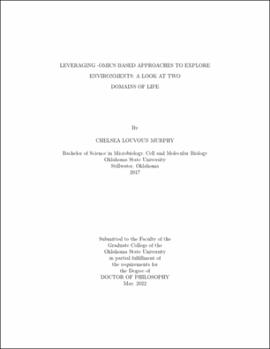| dc.contributor.advisor | Youssef, Noha | |
| dc.contributor.author | Murphy, Chelsea Louvoun | |
| dc.date.accessioned | 2023-03-16T21:14:17Z | |
| dc.date.available | 2023-03-16T21:14:17Z | |
| dc.date.issued | 2022-05 | |
| dc.identifier.uri | https://hdl.handle.net/11244/337115 | |
| dc.description.abstract | Rapid advancements in technology have both dramatically lowered the cost of sequencing as well as increased the depth of information gleaned. With such a low barrier of entry, increasing numbers of scientists around the globe are generating unprecedented amounts of data pertaining to the identity and function of the various microbes that impact assorted environments, from within a host to various biomes in nature. Understandably, a pressing challenge in the field centers on how to process and interpret these large quantities of precise information. The leveraging of -omics based techniques used in bioinformatics stands poised to answer this challenge, enabling discoveries that probe not just what a microbe can do, but also perhaps provide a look into their past through an analysis of their genetic potential. | |
| dc.description.abstract | For my overall project, I sought to leverage various -omics based approaches to study how various organisms impact and have been impacted by their respective environments. My work has spread from transcriptomics to proteomics and finally metagenomics, from pure cultures to environmental samples, and from fungi to bacteria. At the surface levels, these works provide a form of functional profile of the studied organisms; however, deeper insights into the potential evolutionary history can also be made. For example, the study on the anaerobic gut fungal phylum Neocallimastigomycota (Chapter I) can provide insights into the clade's intertwined history with the development of herbivory, the study on the obligate plant symbiont Rhizophagus irregularis (Chapter II) can provide insight into fungal association with plants, the metagenomic studies of the Binatota (Chapter III) and novel Desulfobacterota classes (Chapter IV) can provide insights into the development and evolution of the Delta Proteobacteria into a diverse clade, and the study of novel Myxococcota classes (Chapter V) can provide clues into the development of predation strategies in bacteria. As a whole, this body of works provides a jumping-off point for future probes into these organisms, as well as potential isolation strategies for the uncultured organisms discussed. | |
| dc.format | application/pdf | |
| dc.language | en_US | |
| dc.rights | Copyright is held by the author who has granted the Oklahoma State University Library the non-exclusive right to share this material in its institutional repository. Contact Digital Library Services at lib-dls@okstate.edu or 405-744-9161 for the permission policy on the use, reproduction or distribution of this material. | |
| dc.title | Leveraging -omics based approaches to explore environments: A look at two domains of life | |
| dc.contributor.committeeMember | Elshahed, Mostafa | |
| dc.contributor.committeeMember | Hoff, Wouter | |
| dc.contributor.committeeMember | Fathepure, Babu | |
| dc.contributor.committeeMember | DeSilva, Udaya | |
| osu.filename | Murphy_okstate_0664D_17564.pdf | |
| osu.accesstype | Open Access | |
| dc.type.genre | Dissertation | |
| dc.type.material | Text | |
| dc.subject.keywords | metagenomics | |
| dc.subject.keywords | Neocallimastigomycota | |
| dc.subject.keywords | proteomics | |
| dc.subject.keywords | Rhizophagus | |
| dc.subject.keywords | transcriptomics | |
| dc.subject.keywords | uncultured | |
| thesis.degree.discipline | Microbiology, Cell and Molecular Biology | |
| thesis.degree.grantor | Oklahoma State University | |
